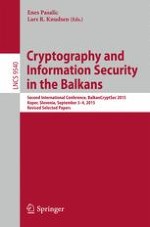2016 | Buch
Cryptography and Information Security in the Balkans
Second International Conference, BalkanCryptSec 2015, Koper, Slovenia, September 3-4, 2015, Revised Selected Papers
herausgegeben von: Enes Pasalic, Lars R. Knudsen
Verlag: Springer International Publishing
Buchreihe : Lecture Notes in Computer Science
